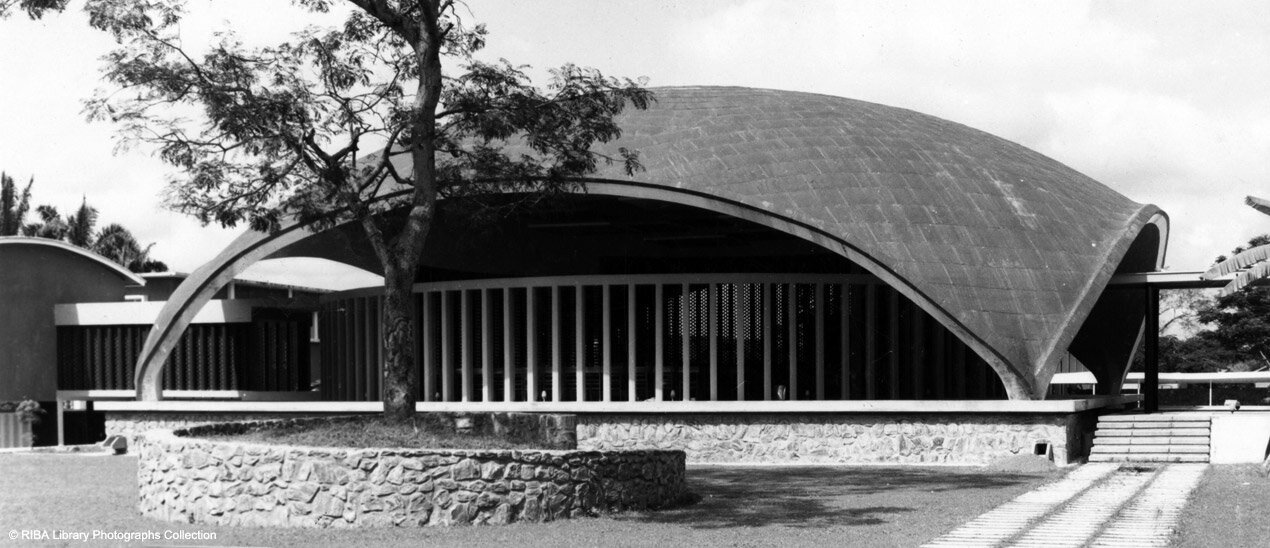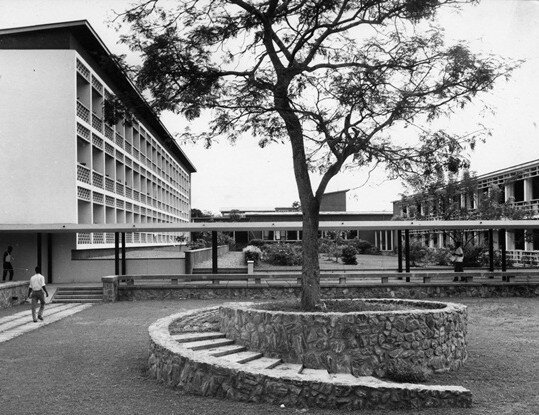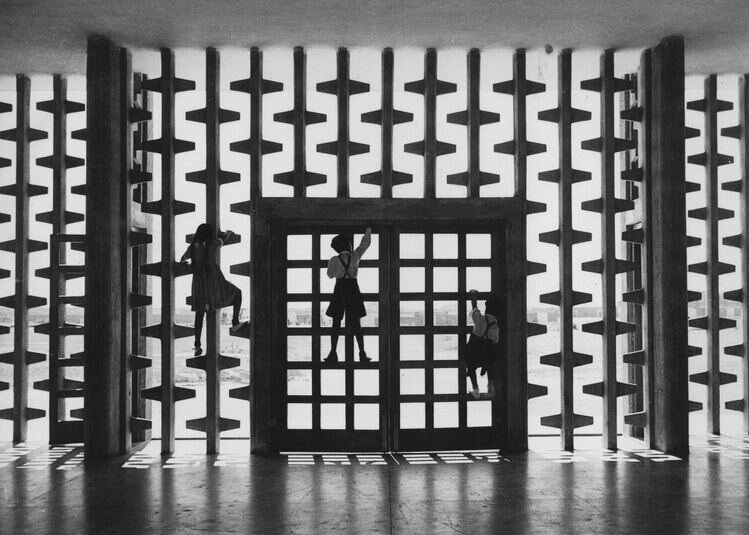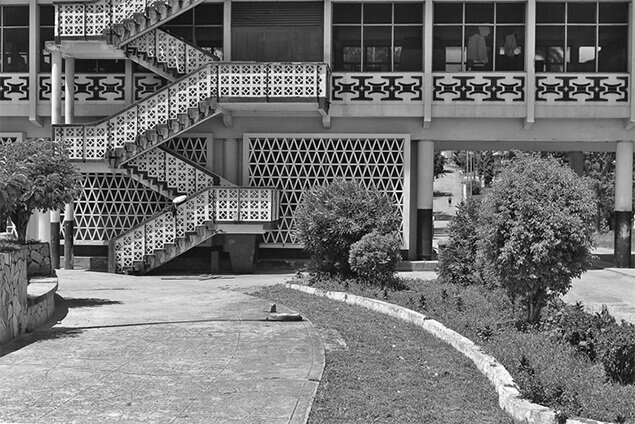Episode 07: Jane Drew
Jane Drew began the first all woman architecture firm in London. She was born on March 24, 1911, in England. She graduated from the AA School of Architecture in 1934. Architecture firms rejected her simply because she was a woman. This motivated her to start an all woman architecture firm in 1939. The architecture practice was named “Jane B Drew”. From 1944 to 1946 she was Assistant Town-Planning Adviser to the resident minister for the British colonies in Africa. She got paid £100 less than everyone else just because she was a woman. Jane and her husband, Max Fry, formed the firm Fry, Drew, and Partners focusing on large-scale planning for tropical countries. That was the end of the all woman firm, but it's all right. Indian Prime Minister Nehru invited her firm to lead the design of the city Chandigarh. Yet, she was too busy to run the project and she recommend Le Corbusier. Le Corbusier accepted, he along with Jane, Max, Pierre Jeanneret, and a big team of Indian architects worked on Chandigarh for years. Other notable works from Jane include: The University of Ibadan, Nigeria, the School for the Deaf, London, and the Open University England, and the Torbay Hospital and Nurses Residence in England in the 1970s. She stopped practicing in the late 1970s, but kept traveling and lecturing. She passed away on 1996.
Publications
Jane Drew and John Heartfield, Kitchen Planning: a brochure of new plans and suggestions for labour saving kitchens. London: The Gas Industry, 1945.
J. B. Drew and E. Maxwell Fry, Village Housing in the Tropics: with special reference to West Africa, In collaboration with Harry L. Ford. London: Lund Humphries, 1947.
E. Maxwell Fry and Jane B. Drew, Chandigarh and Planning Development in India, London: Journal of the Royal Society of Arts, No.4948, 1 April 1955, Vol.CIII, pages 315–333. I. The Plan, by E. Maxwell Fry, II. Housing, by Jane B. Drew.
E. Maxwell Fry and Jane Drew, Tropical Architecture in the Dry and Humid Zones. New York: Reinhold, 1964.
Jane Drew, Ann Tyng, Gae Aulenti, Denise Scott Brown, Monica Pidgeon, Anna Bofil, Indira Rai, Bola Sobande, Ellen Perry Berkeley, Eulie Chowdhuri and others. The crisis of Identity in Architecture – Report of the proceedings of the International Congress of Women Architects. Ramsar, Iran, 1976.
Media
Check out this lecture Jane gave regarding Chandigarh: https://www.youtube.com/watch?v=QasRHHhjPdM&feature=emb_imp_woyt
Caryatid: Alda Ly
Alda Ly is the owner of Alda Ly Architecture and Design in New York City. She also co-founded Designer’s Assembly which supports young architects who aspire to ethical creatively fulfilling entrepreneurship. Alda’s project list includes retail, healthcare, media labs, cultural spaces, and co-working office spaces for women. Her work has been featured nationally and internationally in various publications. She is an alumni of UC Berkeley and Harvard University’s Graduate School of Design.
Check out article about her in Madame Architect: https://www.madamearchitect.org/interviews/2018/6/11/without-precedent-alda-ly-on-new-motherhood-starting-a-firm-and
-
This transcript was prepared during the development of the episode.
Final recorded episode may deviate slightly from the content presented below as changes, edits, or improvements may be made during the recording and editing process.
Norgerie: Hi! Welcome to She Builds Podcast where we share stories about women in the design and construction field one lady at time. Today we’re gonna talk about Jane Drew, the architect who began the first all woman architecture firm in London. I’m Norgerie Rivas registered to vote in Houston Texas.
Jessica: Hi, I’m Jessica Rogers sheltering in place out of Washington DC
Lizi: Hi, I’m Lizi Raar, coming to you from San Francisco.
Norgerie: Yeay! Now that we’ve introduced ourselves, quick disclaimer. The three of us are not historians, nor are we experts on this subject.
Jessica: Yeah, we are just sharing stories on the information that we find about each woman. If we get our facts a little mixed up, please forgive us, leave us a comment and we will all continue learning.
Norgerie: All right let's start. The time was March 24, 1911, the place Thornton Heath, England. Iris Estelle Radcliffe Drew was born.
Jessica: I thought her name was Jane?
Norgerie: Not the first few days of her life. Then her parents changed their minds and she became Joyce Beverly Drew, known as Jane Drew.
Lizi: Why so many changes? And is Jane a nickname for Joyce that I didn’t know about?
Norgerie: Who, knows I couldn't make the connection between Joyce and Jane, but they did I guess. Her dad, Harry Drew was a designer of surgical instruments and the founder of the British Institute of Surgical Technicians. Her mother was Emma Spering Jones, a school teacher and a botanist. Jane had an older sister, Dorothy Stella Radcliffe Drew, who became a physician. Jane studied at Croydon High School which is a day school for girls. I thought that was cool because I went to an all girl high school too.
Jessica: Did you really? How was that?
Norgerie: Really great! It felt like a big camaraderie. I highly recommend it. I mean there was still high school drama and stuff but in general I enjoyed school.
Lizi: I just can’t imagine going to an all girls school, but I am glad you enjoyed it. Hopefully Jane did too.
Norgerie: Right! Well, she was Head Girl, which sounds important . At Croydon she was friends with actresses Peggy Ashcroft. The two of them made a pact that they would become career women and they would never change their names.
Jessica: That sounds like something you would do too.
Norgerie: Sure did, Norgerie Rivas, for life. Funny story, one time Jane was going to give a lecture and she was introduced as Mrs. Fry, because, well spoiler alert, she married a famous architect, but be surprised later when I tell you that.
Jessica: you got it.
Norgerie: So Mr. Didn’t Do His Homework, introduces Mrs. Fry, and she goes up to him and corrects him. And so he tells the audience "I'm sorry Mrs. Fry can't be with us tonight, instead Miss Jane Drew has kindly accepted to replace her." Is it me or is that a really lame save?
Jessica: Yeah, what was that?
Lizi: That makes it sound like she was Option B.
Norgerie: YES! Ok, After Croydon school, Jane went to the Architectural Association School of Architecture aka the AA.
Jessica: That’s a famous school in London, right?
Lizi: Yeah, it's one of the most prestigious and competitive in the world. Famous architects went there like Denise Scott Brown and Zaha Hadid.
Norgerie: And Jane Drew.
Jessica: LEGENDS
Lizi: Oh heyyy.
Norgerie: She graduated from the famous AA in 1934, she was 23, and like many of her gender, she could not find a job in architecture. She would go to firms and they would tell her sorry we just don’t hire women. Yet she noted that they all had women secretaries. So she was like this is crap, and decided that when she started her own firm she would only hire women.
Jessica: You Go Woman!
Norgerie: Yeah, well before she did that, she got married to a fellow AA classmate, and they worked together for a while, had twin girls and then got divorced in 1939. That same year, at 28, she began the first all woman architecture practice named Jane B Drew.
Jessica: Yeahhhh!
Lizi: What did they work on?
Norgerie: Guess what women architects would get hired to do.
Jessica: Kitchens.
Norgerie: Yep.
Jessica: Seriously?
Norgerie: Seriously, but she set out to make the best kitchens the world had ever seen. She did a lot of research and found out the average height of British women had gotten taller and so she raised kitchen tops in her designs. And she proposed integrated kitchens that had everything, including washing machines, which was like mind blown ideas, at the time. She went to the Ministry of Housing to share her revolutionary thoughts about efficiency so that they could become more standard and they told her “Miss Drew, saving women’s labour in the home doesn’t help the economy.” What do you ladies make of that?
Jessica: I’m still stuck on the Ministry of Housing? And second of all... that’s BS! Women’s labour in the home DOES help the economy. And the jokes on them because it's common to see washing machines in kitchens. Douffuses
Lizi: To me that’s super short-sighted, and sounds like they just didn’t want to listen to her.
Norgerie: Mhm, Do you guys remember what else started in 1939?
Lizi: World War II
Norgerie: Yep
Jessica: Oh so she was a wartime architect, did that influence her work?
Norgerie: Yes, her firm worked on air-raid shelters for children in Hackney, London. Thanks in part to that work and her growing reputation Jane served as chair of the "Rebuilding Britain" exhibition at London's National Gallery in 1943. Another way the war affected her professionally was that her office, which was also her home, in fact throughout most of her career her office was in her home, well anyway her office/home was bombed once.
Jessica: WAIT WHAT???
Norgerie: Well, something that caught my eye immediately about Jane was that she was buddies with a little architect that went by the name of Le Corbusier.
Jessica: Oh, Norgerie, non architects won't know you’re being sarcastic.
Norgerie: True, ok, Le Corbusier is a big, huge name in architecture, he was part of the also very famous modern movement. Corbu, as we like to call him, was a founder of the Congrès internationaux d'architecture moderne International Congress of Modern Architecture or CIAM, which Jane went to because she’s buddies with Corbu, or maybe they met there, anyway, that happened in Switzerland in 1928 and then Jane became part of the Modern Architecture Research Group better known as MARS which was the British subgroup of CIAM. And one of the founders of MARS was Maxwell Fry, who SURPRISE, Jane married in 1942.
Jessica: I am surprised. Who was Maxwell Fry and what did MARS do?
Norgerie: Maxwell was a modernist architect, known at the time for his involvement with the MARS group. He worked with other modernist architects, like Corbusier and Walter Gropius. And a lot of the famous things he did, he did with Jane so I will tell you about those soon. The MARS group had a radical plan to redesign postwar London, they had an exhibition and publications. It was all a promising interesting idea that didn't get built.
Jessica: Sounds like a lot of architecture projects…. That we can only see in books.
Lizi: Haha, yeah. Tell us more about work that Jane did that did get built.
Norgerie: Yeah! Ok, Jane got married and then she got involved with architecture in the British West African colonies. From 1944 to 1946 she was assistant town-planning adviser to the resident minister for the colonies. She got paid £100 less than everyone else simply because she was a woman, of course. Even though she was paid less she worked super hard, also of course, she learned the local language so that she could converse and learn from the villagers what they needed in their homes and towns. She became the liaison between the Colonial Office and West Africa. And then she started having this idea that one shouldn't design buildings in tropical locations like Nigeria, in the same way they design for northern London.
Lizi: Imagine that!
Norgerie: Incredible. She did so much research, she paid a lot of attention to the harmony of design with the environment, responded to topography, incorporated local motifs, studied the climate, ecology, and regional culture. She learned how sun, shade, and landscape were essential to human comfort and good design. With all of these principles in mind, she and Max formed the firm Fry, Drew and Partners focusing on large-scale planning for tropical countries, so that was the end of the all woman firm, but it's ok. They wrote Village Housing in the Tropics in 1947, andTropical Architecture in the Humid Zone in 1964 which became standard works architects would study.
Jessica: Jane was taking them to school.
Norgerie: Sure was, actually among her most famous works there are a few institutes and schools, like The University of Ibadan, Nigeria completed in 1959, the Institute of Contemporary Arts, London 1964, the School for the Deaf, London 1968, and the Open University England 1977. Actually I am jumping ahead but since I mentioned Open University, this project was interesting because she was approached by the Labour Party to work on an experimental university in 1969, and if you go on their website it seems like a unique university in terms of their curriculum and how it works. And she worked on it extremely fast to get the project too far along before a change in government could stop it.
Lizi: Those are very unique and interesting sounding projects. I bet designing space for the deaf is very different than designing a school for the hearing, and it sounds like Jane would do her homework and present the best space she could for any particular situation.
Norgerie: I agree. Well speaking of varied and important projects let's talk about a very famous one for us architects, and honestly the reason I was drawn to Jane in the first place. What do you both think of when you hear Chandigarh, India?
Jessica: Corbi CORB
Lizi: Corbu
Norgerie: Me too, I think about our buddy Le Corbusier, it's one of his most famous projects that we learned about in school. But no one told us that if it had not been for Jane Drew, Le Corbusier would not have even been involved with the project at all.
Jessica: Hold up, hold the phone, what do you mean?
Norgerie: After seeing Jane’s projects in Africa, remember she was working in the British Colonies, Indian Prime Minister Nehru asked her and Max to design the new capital of the state of Punjab, Chandigarh. Let's talk about how HUGE this is, and she was only 38 years old.
Jessica: Designing a city is like an architect’s dream right? To design how a population moves, where, and how they live. Their streets, housing, work and government buildings. There are video games about this, imagine doing it in real life, she got invited to do that, it's incredible. REAL LIFE SIMS AND MINECRAFT - so jelly.
Lizi: And remind us when this was?
Norgerie: 1950
Lizi: So English colonialism had JUST ended in 1947. Imagine the political climate around this project as well.
Norgerie: Yes, super complex project, we could talk about it for hours. But we only have 30 minutes to talk about Jane Drew. Well, fortunately for Corbu, Jane was super busy with the Festival of Britain and she was also working on a hospital for the Kuwait Oil Company, among other things. And so I am sure she told the Prime Minister, listen I want to be involved in this, designing a city is amazing, but I just can't lead this project right now, let me introduce you to my innovative, super smart and talented architect friend, Le Corbusier. And so she convinced the Prime Minister to let Corbusier lead the project and she would work alongside him. The Prime Minister agreed as long as she was still involved in the project. That’s how important she was! So, the Prime Minister signs off, Corbusier starts to work on the project. Once Jane was done with her previous work engagements she lived in Chandigarh for three years, along with Max and Corbusier’s cousin Pierre Jeanneret, who is also a well known architect, working with a team of Indian architects and engineers, while Corbu would only swing by a few months at a time because India was too hot. Yet somehow Corbusier is the one to get all the glory.
Lizi: Of course he does
Norgerie: I have a book on Le Corbusier, there is a whole chapter on this project. Jane Drew is mentioned ONCE, in passing, as a collaborator. The chapter starts by saying Corbusier got sought out by the Indian government at his studio. Which I don't doubt it's true but the book so curiously skips how/ why the government sought out Corbusier.
Jessica: BUT CAN WE TALK ABOUT HOW IN SCHOOL THEY SHOVED CHANDIGARH DOWN OUR THROATS BUT THEY NEVER MENTIONED THIS WOMAN. It's part of the erasure of women architects from architecture history. There are articles about this we can post on our show notes. For example, the very controversial case of the Pritzker Prize snub of Denise Scott Brown.
Lizi: Oh yeah very long story short, Architects Denise Scott Brown and her husband Robert Venturi owned their own firm and published a lot of important work together. Yet in 1991 the Pritzker Prize, which is a very famous prize in architecture, was awarded solely to Robert for work he did with Denise.
Norgerie: Now that you mention that, it reminds me that Jane was offered a life peerage which is a noble title that cannot be transferred, meaning her children cant inherit it, and she turned it down because, in her own words “it leaves out Maxie”. Which when I read that totally reminded me of Robert Venturi accepting the Pritzker Prize even though he knew that it was leaving Denise out. He even mentioned it during his acceptance speech that the award was as much Denise’s as it was his.
Lizi: Could he have rejected the prize? I know she didn’t attend the ceremony because of it.
Jessica: Well we could all probably agree that the juries that make these decisions are mostly buttholes but I appreciate that Robert stuck up for his partner. The same as Jane that stuck up for her Maxie.
Norgerie: Yeah, in 2013 he signed a petition that the award should be retrospectively shared with Denise, but that was 22 years later! Took a while, I mean I am sure that it's all very political and complex and there were a lot of behind the scenes that we don't know about but still...
Jessica: 22 F’ ing years! Learning from Las Vegas is one of the most influential theory books that they also shoved down our throats. It’s so frustrating that they waited until 2013 for them to get a petition started but even then…. they didn't though, the pritzker prize rejected the request because they didn't want to set a precedent of overturning decisions….
Lizi: Yeah, and Learning from Las Vegas which is their most notable work was actually a project that Denise wanted to research and explore, and she invited Bob to join her in it. So it was her idea.
Norgerie: This sorta feels like a good segway to talk about her accolades but I barely scratched the surface of her work. There is just too much to talk about Jane in such little time!
Lizi:
Norgerie: Let me just mention a few more projects as fast as I can.
Jessica: LET’S DO IT.
Norgerie: In 1961 she was Visiting Professor at MIT, and she was writing Tropical Architecture in the Dry and Humid Zones. Also she was giving lectures, being interviewed on radio and television shows, and you know just being a starchitect. She is quoted to have told Max ‘I have seen everyone, lunched with Gropius, dined with Serge, drinks with Sert, breakfast with Giedion. Have started my class, taken part in a jury with Kahn − it’s all very stimulating and interesting …’
Jessica: All that name dropping
Lizi: Funny how she calls almost everyone by their last name.
Norgerie: In the late 1950s she started working on a major housing complex for the Iran Oil Company. When the executives found out a woman was involved they tried to pull out of the project. And they made things really difficult for her firm. But the Shah of Iran at the time convinced them to cut the nonsense. Jane worked on those projects for decades, they did clinics and universities as well. Yet in 1979 the Iranian monarchy was overthrown and all payments to her firm stopped. The firm had to declare bankruptcy.
Lizi: Oh no.
Jessica: OH SNAP
Norgerie: But not to worry the firm kept going after that. Another big project was the Torbay Hospital and Nurses Residence in England in the 1970s. She wanted to be very careful to design a hospital that was friendly and not scary so she became good friends with the nurses. She Even stayed overnight with them.
Lizi: She really was committed to the research.
Norgerie: She really was. Now lets talk about her accolades, will you guys help me?
Lizi: Sure, she was a visiting professor in MIT, Harvard and the University of Utah, and she received honorary degrees from the University of Ibadan in Nigeria, Open University, England Newcastle University, England and the University of Witwatersrand, South Africa.
Jessica: She was an Honorary Fellow of the American Institute of Architects and of the Nigerian Institute of Architects. She was also the President of the Architectural Association and a member of the Royal Institute of British Architects.
Norgerie: And in 1996, she was named Dame Commander of the Order of the British Empire, that means we should have been calling her Dame Jane this whole time.
Lizi: Oops...
Norgerie: I didn’t want to spoil the surprise.
Jessica: that’s ok.
Norgerie: Well, on July 27, 1996 she passed away from cancer at 85 years young.
Jessica: WOW in accent Dame Commander Jane of the Order of British Empire, who knew that she had so much influence in the world of architecture, it is such a shame that we didn’t learn more about her in school. But I am glad we got to know about her now.
Lizi: Agreed, she did so many things, and we knew nothing about her, which is crazy. I wonder if they learn more about her at schools in the UK.
Norgerie: Hopefully! All right, time for our caryatid! Your cue Lizi.
Lizi: A Caryatid is a stone carving of a woman, used as a column or a pillar to support the structure of a Greek or Greek-style building. At the end of each episode we’ll choose a “caryatid” -- a woman who is working today, furthering the profession through their work, and who ties in to the historical woman of our episode.
Norgerie: This week’s caryatid is… Alda Ly! Woohooo. I saw Alda speak at a conference about how she started her firm and it was really inspiring. She began her firm, by herself, in 2017. As we can imagine this was a lot of work, and about a year later she got pregnant. So halfway through her pregnancy, her firm was a total of three people and she was at a crossroads. Either she would, you know, calm it down, or double down. I think at the conference she explained that they had a lot of work for three people to handle, but growing your firm is also a lot of work right?
Jessica: Definitely, the process of hiring people, training them, HR, finding a space for everyone...
Norgerie: So at this point something’s gotta give. The natural answer would be calm it down while you are pregnant, but she didn't want to lose the momentum and the clients she had been building up, so she went all in, she got more projects, she hired more people she didn't stop through her entire pregnancy it was go go go.
Lizi: Sounds like Serena Williams winning the Australian Open while pregnant.
Norgerie: Yeah, Alda was like (smack lips) Grand Slam. There is a wonderful article about her in Madame Architect we will include in the shownotes. Well the reason I picked Alda today was because she is the Architect in a project called The Wing. The Wing are co-working spaces, like WeWork, but more than co-working, they are sort of a social club, you should check out their website but what's really interesting is that they are designed for women.
Jessica: Ahhh like the all woman architecture firm of the Jane Drew early days.
Norgerie: So there is a bit of controversy around The Wing, but that has nothing to do with the spaces Alda designed which are amazing. And there are locations all over the US designed by her. There so much more we could say about Alda but we are out of time.
Lizi: Aww man
Norgerie: Before we sign off we want to thank CMYK for the music, check them out on Spotify. John W our technical producer. And most of all thank you for listening! We hope you enjoyed learning about Jane and Alda, along with our banter, and that you are inspired to find out more about them and other amazing professional ladies. Again, thank you!
Jessica: Please let us know what you thought of our episode. We are excited to hear from you and for you to come back and keep learning about women bosses with us. You can email us your thoughts at shebuildspodcast@gmail.com, leave us a comment on our website shebuildspodcast.com or follow us on instagram and facebook @shebuildspodcast, or on twitter @shebuildspod. Until then, BYE!
References
“Drew, Jane (1911–1996) | Encyclopedia.Com.” Encyclopedia.Com, www.encyclopedia.com/women/encyclopedias-almanacs-transcripts-and-maps/drew-jane-1911-1996. Accessed 27 May 2020.
Gamolina, Julia. “Without Precedent: Alda Ly on Starting a Firm, Becoming a Mom, and Doing What’s Never Been Done.” Madame Architect, 21 June 2018, www.madamearchitect.org/interviews/2018/6/11/without-precedent-alda-ly-on-new-motherhood-starting-a-firm-and.
Green, Emily. “The Independent.” The Independent, 7 Mar. 1990, chanceofrain.com/wp-content/uploads/2009/04/jane-drew-interview.htm.
Jackson, Ian. “Jane Drew (1911-1996).” Architectural Review, 4 July 2017, www.architectural-review.com/essays/reputations/jane-drew-1911-1996/8665224.article.
Morais, Betsy. “‘The Wing:’ A Feminist Office, Designed by a Woman.” The Atlantic, 12 Apr. 2018, www.theatlantic.com/business/archive/2018/04/an-architect-for-the-feminist-moment/557516.
Narro, Itziar. “Did You Know There Was One More Architect (a Woman) Who Built Chandigarh Together with Le Corbusier?” Architectural Digest India, 5 July 2020, www.architecturaldigest.in/content/know-everything-about-jane-drew-the-architect-who-built-chandigarh-together-with-le-corbusier/#s-cust0.
Raskin, Laura. “Meet the Designers Behind The Wing, the Coworking Space For Women.” Metropolis, 7 Aug. 2019, www.metropolismag.com/interiors/workplace-interiors/the-wing-chiara-de-rege-alda-ly.
Szacka, Léa-Catherine. “Just What Is It That Made AA’s Women so Different, so Appealing?” Domus, 5 Dec. 2017, www.domusweb.it/en/architecture/2017/11/15/just-what-is-it-that-made-aas-women-so-different-so-appealing.html.
Venturi, Robert. “Robert Venturi 1991 Laureate Acceptance Speech.” The Pritzker Architecture Prize 1991, 1991, www.pritzkerprize.com/sites/default/files/inline-files/1991_Acceptance_Speech.pdf.
Wikipedia contributors. “Jane Drew.” Wikipedia, 1 July 2020, en.wikipedia.org/wiki/Jane_Drew.
Images (in order of appearance):
RIBA Library Photographs Collection. University College, Ibadan: Residential College 3 dining hall (Sultan Bello Hall). Livin Spaces. A Nenayo Media Company © Livin Spaces 2020. 20 Jan. 2017. www.livinspaces.net/interviews-and-articles/fry-drew-and-partnersthe-british-architects-behind-the-university-of-ibadan-campus/
Iain Jackson. Chandigarh Art Gallery. ArchIpel. 26 Nov. 2013. archipelvzw.be/en/agenda/458/maxwell-fry-jane-drew-in-chandigarh
Sergio Kreiman. Conjunto Habitacional en Chandigarh. Un Dia Una Arquitecta. 06 May 2015. undiaunaarquitecta.wordpress.com/2015/05/06/jane-drew-1911-1996/
Tripti Joshi. Unnamed. Alchetron. 03 Apr. 2018. chameleon-circle-gmmg.squarespace.com/config/pages/5e43442d685c425c5d4940c6
Sergio Kreiman. Fry, Drew and Partners, Independence Arch, Accra (Ghana). Un Dia Una Arquitecta. 06 May 2015. undiaunaarquitecta.wordpress.com/2015/05/06/jane-drew-1911-199
Iain Jackson, Mfantsipim School, Cape Coast, Ghana (1958) Fry, Drew and Partners. The Architectural Review. Tropical Modernism: Fry and Drew’s African Experiment. 4 Jul 2014 https://www.architectural-review.com/essays/tropical-modernism-fry-and-drews-african-experiment







